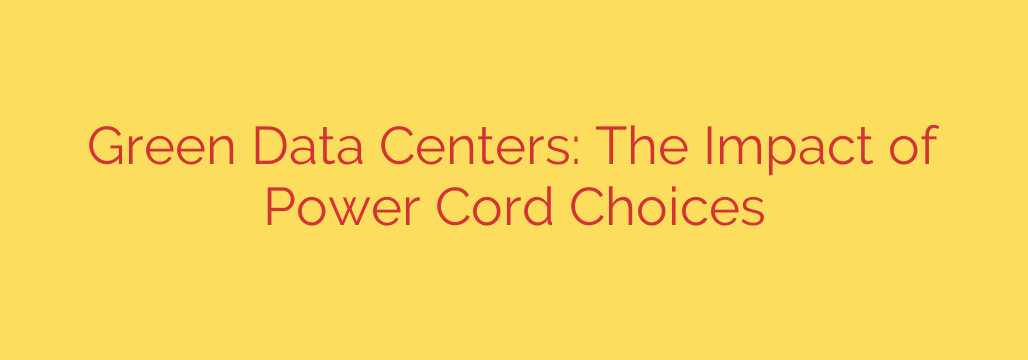
The Overlooked Key to a Greener Data Center: Why Your Power Cords Matter
Data centers are the engines of our digital world, but they come with a voracious appetite for electricity. As energy costs rise and environmental concerns grow, the push for “green data centers” has become a top priority for IT managers and facility operators. The industry standard for measuring efficiency is Power Usage Effectiveness (PUE), a ratio that compares a facility’s total power consumption to the power delivered to IT equipment.
While most efficiency efforts focus on massive cooling systems and next-generation servers, a critical component is often completely ignored: the humble power cord. It may seem insignificant, but your choice of power cords has a direct and measurable impact on your energy consumption, heat generation, and overall PUE score.
The Hidden Drain on Your PUE
In the complex ecosystem of a data center, every watt counts. The primary function of a power cord is to deliver electricity from the Power Distribution Unit (PDU) to the server. However, no transfer of energy is 100% efficient. A portion of that electrical energy is inevitably lost as heat due to the cord’s internal resistance.
This is where the problem begins. Inefficient power cords act as small, silent heaters inside your server racks. While a single cord’s heat output is minor, multiplying that by thousands of servers creates a significant thermal load that your cooling infrastructure must then combat.
The Science of Inefficiency: Wire Gauge Matters
The efficiency of a power cord is largely determined by its wire thickness, measured by the American Wire Gauge (AWG) standard. Here’s the crucial takeaway: a lower AWG number signifies a thicker wire, which has less electrical resistance.
- High Resistance (Thinner Wires): Cords with a higher AWG number (e.g., 18AWG or 16AWG) are thinner and have more resistance. As electricity flows through them, more energy is converted into waste heat.
- Low Resistance (Thicker Wires): Cords with a lower AWG number (e.g., 14AWG or 12AWG) are thicker. Their reduced resistance means less power is lost as heat, allowing more electricity to reach the server.
Choosing a 12AWG cord over a standard 14AWG cord for a high-draw server can dramatically reduce heat generation. This small change, when scaled across an entire data center, translates into a significant reduction in wasted energy.
The Compounding Effect on Your Cooling Systems
The heat generated by inefficient power cords doesn’t just disappear. It radiates into the server rack and the surrounding cold aisle, raising the ambient temperature. This triggers a costly chain reaction.
This extra heat forces your Computer Room Air Conditioning (CRAC) units to work harder and run longer to maintain safe operating temperatures. Because cooling is one of the largest power consumers in any data center, this additional workload directly inflates your facility’s total energy consumption and worsens your PUE score. By selecting more efficient, lower-gauge power cords, you not only reduce direct power loss but also decrease the secondary burden on your expensive cooling infrastructure.
Actionable Steps for Optimizing Your Power Cord Strategy
Migrating to a more efficient power infrastructure doesn’t have to be an overwhelming overhaul. By focusing on smart, incremental changes, you can achieve substantial gains in efficiency and cost savings.
Prioritize Lower Gauge Cords for High-Power Devices: Audit your racks and identify your most power-hungry servers and network equipment. Make it a policy to use thicker, lower-resistance cords (e.g., 12AWG) for these critical assets to minimize heat loss where it matters most.
Use the Right Length for the Job: Excess cable length increases resistance. Avoid the common practice of using overly long cords and coiling the slack behind the rack. This practice, known as “coiling,” can trap heat and further increase electrical resistance. Order and install power cords that are appropriately sized for the distance between the PDU and the server inlet.
Conduct a Power Infrastructure Audit: Don’t just focus on new deployments. As part of your regular maintenance cycle, review your existing power cord inventory. Identify older, less efficient cords and create a plan to phase them out in favor of higher-quality, lower-gauge alternatives.
The Bottom Line: Small Changes Lead to Big Wins
In the complex and expensive quest for a green data center, it’s easy to overlook the fundamentals. While advanced cooling technologies and server virtualization are vital, true efficiency is achieved by optimizing every link in the power chain.
Upgrading your power cords is one of the most cost-effective ways to lower energy bills, improve your PUE, and reduce the thermal stress on your valuable IT equipment. By paying attention to this often-neglected detail, you can unlock hidden efficiency gains and take a meaningful step toward building a more sustainable and cost-effective data center.
Source: https://datacenterpost.com/plug-into-sustainability-why-smarter-power-cord-choices-can-help-data-centers-go-green/








